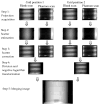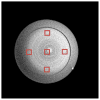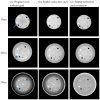Scatter Reduction and Correction for Dual-Source Cone-Beam CT Using Prepatient Grids
- PMID: 26009495
- PMCID: PMC4658322
- DOI: 10.1177/1533034615587615
Scatter Reduction and Correction for Dual-Source Cone-Beam CT Using Prepatient Grids
Abstract
Purpose: Scatter significantly limits the application of the dual-source cone-beam computed tomography by inducing scatter artifacts and degrading contrast-to-noise ratio, Hounsfield-unit accuracy, and image uniformity. Although our previously developed interleaved acquisition mode addressed the cross scatter between the 2 X-ray sources, it doubles the scanning time and doesn't address the forward scatter issue. This study aims to develop a prepatient grid system to address both forward scatter and cross scatter in the dual-source cone-beam computed tomography.
Methods: Grids attached to both X-ray sources provide physical scatter reduction during the image acquisition. Image data were measured in the unblocked region, while both forward scatter and cross scatter were measured in the blocked region of the projection for postscan scatter correction. Complementary projections were acquired with grids at complementary locations and were merged to form complete projections for reconstruction. Experiments were conducted with different phantom sizes, grid blocking ratios, image acquisition modes, and reconstruction algorithms to investigate their effects on the scatter reduction and correction. The image quality improvement by the prepatient grids was evaluated both qualitatively through the artifact reduction and quantitatively through contrast-to-noise ratio, Hounsfield-unit accuracy, and uniformity using a CATphan 504 phantom.
Results: Scatter artifacts were reduced by scatter reduction and were removed by scatter correction method. Contrast-to-noise ratio, Hounsfield-unit accuracy, and image uniformity were improved substantially. The simultaneous acquisition mode achieved comparable contrast-to-noise ratio as the interleaved and sequential modes after scatter reduction and correction. Higher grid blocking ratio and smaller phantom size led to higher contrast-to-noise ratio for the simultaneous mode. The iterative reconstruction with total variation regularization was more effective than the Feldkamp, Davis, and Kress method in reducing noise caused by the scatter correction to enhance contrast-to-noise ratio.
Conclusion: The prepatient grid system is effective in removing the scatter effects in the simultaneous acquisition mode of the dual-source cone-beam computed tomography, which is useful for scanning time reduction or dual energy imaging.
Keywords: CNR enhancement; cross scatter; dual energy imaging; grid blocking ratio; scatter artifact; simultaneous acquisition; total variation regularization.
© The Author(s) 2015.
Conflict of interest statement
All authors certify that his manuscript has not been published in whole or in part nor is it being considered for publication elsewhere. The authors have no conflicts of interest to declare.
Figures










Similar articles
-
Combining scatter reduction and correction to improve image quality in cone-beam computed tomography (CBCT).Med Phys. 2010 Nov;37(11):5634-44. doi: 10.1118/1.3497272. Med Phys. 2010. PMID: 21158275
-
Improved image quality of cone beam CT scans for radiotherapy image guidance using fiber-interspaced antiscatter grid.Med Phys. 2014 Jun;41(6):061910. doi: 10.1118/1.4875978. Med Phys. 2014. PMID: 24877821
-
Enhancement of soft-tissue contrast in cone-beam CT using an anti-scatter grid with a sparse sampling approach.Phys Med. 2020 Feb;70:1-9. doi: 10.1016/j.ejmp.2020.01.004. Epub 2020 Jan 10. Phys Med. 2020. PMID: 31931280
-
A general framework and review of scatter correction methods in x-ray cone-beam computerized tomography. Part 1: Scatter compensation approaches.Med Phys. 2011 Jul;38(7):4296-311. doi: 10.1118/1.3599033. Med Phys. 2011. PMID: 21859031 Review.
-
The principles and effectiveness of X-ray scatter correction software for diagnostic X-ray imaging: A scoping review.Eur J Radiol. 2023 Jan;158:110600. doi: 10.1016/j.ejrad.2022.110600. Epub 2022 Nov 17. Eur J Radiol. 2023. PMID: 36444818
Cited by
-
Advanced 4-dimensional cone-beam computed tomography reconstruction by combining motion estimation, motion-compensated reconstruction, biomechanical modeling and deep learning.Vis Comput Ind Biomed Art. 2019;2(1):23. doi: 10.1186/s42492-019-0033-6. Epub 2019 Dec 12. Vis Comput Ind Biomed Art. 2019. PMID: 32190409 Free PMC article.
-
Enhancing liver tumor localization accuracy by prior-knowledge-guided motion modeling and a biomechanical model.Quant Imaging Med Surg. 2019 Jul;9(7):1337-1349. doi: 10.21037/qims.2019.07.04. Quant Imaging Med Surg. 2019. PMID: 31448218 Free PMC article.
-
Estimating 4D-CBCT from prior information and extremely limited angle projections using structural PCA and weighted free-form deformation for lung radiotherapy.Med Phys. 2017 Mar;44(3):1089-1104. doi: 10.1002/mp.12102. Med Phys. 2017. PMID: 28079267 Free PMC article.
-
Dynamic CBCT imaging using prior model-free spatiotemporal implicit neural representation (PMF-STINR).Phys Med Biol. 2024 May 23;69(11):115030. doi: 10.1088/1361-6560/ad46dc. Phys Med Biol. 2024. PMID: 38697195 Free PMC article.
-
A Biomechanical Modeling Guided CBCT Estimation Technique.IEEE Trans Med Imaging. 2017 Feb;36(2):641-652. doi: 10.1109/TMI.2016.2623745. Epub 2016 Nov 1. IEEE Trans Med Imaging. 2017. PMID: 27831866 Free PMC article.
References
-
- Jaffray DA, Siewerdsen JH. Cone-beam computed tomography with a flat-panel imager: initial performance characterization. Medical physics. 2000;27:1311–1323. - PubMed
-
- Siewerdsen JH, Moseley DJ, Burch S, Bisland SK, Bogaards A, Wilson BC, Jaffray DA. Volume CT with a flat-panel detector on a mobile, isocentric C-arm: pre-clinical investigation in guidance of minimally invasive surgery. Medical physics. 2005;32:241–254. - PubMed
-
- Xing L, Siebers J, Keall P. Computational challenges for image-guided radiation therapy: framework and current research. Seminars in radiation oncology. 2007;17:245–257. - PubMed
-
- Giles W, Bowsher J, Li H, Yin FF. Interleaved acquisition for cross scatter avoidance in dual cone-beam CT. Medical physics. 2012;39:7719–7728. - PubMed
-
- Li H, Giles W, Bowsher J, Yin FF. A dual cone-beam CT system for image guided radiotherapy: initial performance characterization. Medical physics. 2013;40:021912. - PubMed
Publication types
MeSH terms
Grants and funding
LinkOut - more resources
Full Text Sources
Other Literature Sources

